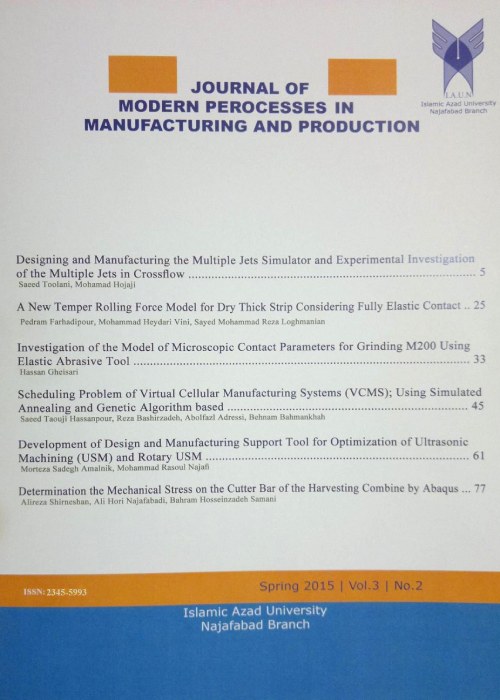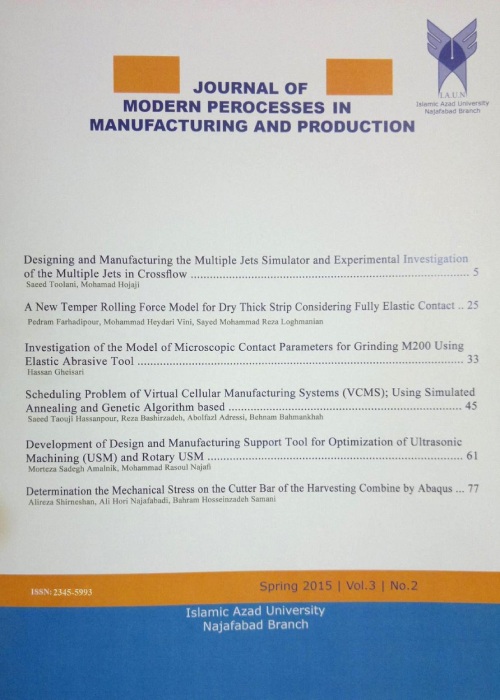فهرست مطالب

Journal of Modern Processes in Manufacturing and Production
Volume:11 Issue: 4, Autumn 2022
- تاریخ انتشار: 1401/11/16
- تعداد عناوین: 6
-
-
Pages 5-21Today, it is common to align broken bones using external bone fixators; ease of installation and adjustability are among the advantages of unilateral external bone fixators compared to circular and horseshoe models. The present study aimed to ensure the stability and strength of the motorized unilateral external bone fixator, equipped with four motors designed in SolidWorks software. The device was simulated and analyzed using the finite element method in Ansys software. The results were as follows: Simulation of compressive, bending, and torsional forces and reliability evaluation using the finite element method in each simulated experiment. The designed device has the necessary stability, rigidity, and desirable reliability to fix the long broken bones in place, with the possibility of displacing the bone when having a lost part. Precise bone displacement is possible since the device has four independent motorized units based on the patient's needs and the instructions of a specialist to rebuild bones.Keywords: Unilateral External Bone Fixator, Bone fracture, Bone Loss, Orthopedics, Finite Element Method
-
Pages 23-36One of the main problems in oil and gas pipelines is abrasion corrosion on the edges of the flow channel in the plug and ball valves. Under normal conditions, the gas is moving at a pressure of about 145 bar and an approximate speed of 70 feet per second; the suspended particles in the gas collide with the edges of the flow channel and cause severe erosion on them. The abrasion resistance of steels depends mainly on their surface properties and can be increased by increasing the surface hardness by friction stir processing (FSP). In this study, A216-WCB steel, which is used in the manufacturing of casting parts for valves, flanges, and fittings, was processed using an FSP for one and three passes. The microstructure, hardness, and wear properties of the processed area were investigated. The results showed that two distinct zones, the stir zone (SZ) and the thermo-mechanical affected zone (TMAZ), are formed in the processed zone. Due to the FSP, the grain size in the stirring region decreased from 25 microns to about 3 microns. The hardness of the SZ increased from 165 Vickers to about 784 HV. Tensile strength increased by 24%, and elongation was reduced by 25% for the processed sample compared to the raw metal. This may be due to phase transformation to martensite and grain size refinement. Also, the abrasion resistance of the stirring area increased up to 2.5 times.Keywords: Friction stir process, wear resistance, Low-carbon steel, Phase transformation, Mechanical Properties
-
Pages 37-45This study aimed to compared mechanical properties and failure mechanisms in ferrite and martensite samples, using Acoustic Emission (AE) Non-Destructive Testing (NDT). The purpose of this study is to identify the phases of ferrite and martensite by analyzing the parameters of AE. Tensile testing was performed on the samples and AE signals were recorded. The Sentry Function (SF) and Fast Fourier Transform (FFT) were used to analyze signals. The results of the martensite sample show that the SF is almost constant at the beginning. This indicates a relative balance between the AE energy and the strain energy. Then the SF took a downward state, which demonstrates a greater ratio of acoustic energy to strain energy. Frequency distribution, one of the best parameters to identify the failure mechanisms in materials for the ferrite sample, is significantly in the range of 175 kHz, while for the martensite sample, this range is between 520 and 700 kHz.Keywords: Martensitic, Acoustic Emission, Fast Fourier Transform, Sentry Function
-
Pages 47-54Wrinkling is a common phenomenon observed in thin membranes when subjected to different loading and boundary conditions. This paper presents the modeling and simulation of wrinkling patterns in the composite membrane using finite element analysis, in which a thin sheet of shape memory alloys (SMAs) material, is used. Shape memory alloys remember their shape even after plastic deformation. Initially, during the analysis a small uniform prestress is applied to the membrane, to stabilize it. Then in the next step of the analysis, we determine buckling mode-shapes of the prestressed membrane. In the next step, these modes are used as small, initial imperfections that trigger the formation of wrinkles in the preceding nonlinear geometric simulation. Thermal effect on the shape memory alloy sheet was considered after it has deformed/wrinkled and wrinkle characteristics are obtained. The result is then demonstrated by computing the characteristics of wrinkles in two membrane structures one without the shape memory alloy sheet and one with the shape memory alloy sheet. It has been observed that smart structure, shape memory alloy has an effective control of the wrinkle of the membrane.
-
Pages 55-66In this study, the distribution of boron carbide in the stir zone of the FSPed specimens was examined experimentally and numerically about probe shape, including circular, square, and hexagonal shapes. First, composites were created using different tools. Then, using an optical microscope, the microstructural properties of the samples, such as the size and shape of the silicon particles, were examined. To simulate the procedure and further explore particle distribution, the coupled Eulerian-Lagrangian (CEL) method is employed. The tool was also modeled using a Lagrangian formulation while the material was characterized using an Eulerian formulation. The model predicted the changes in strain and temperature in composites created with different probe shapes. The outcome demonstrated that the circular probe was not suitable for the production of composites because it could not disperse particles in the parent alloy. Tools with flat surfaces, such as square and hexagonal tools, have more evenly distributed metal particles. Square probes can be employed in the FSP process to create composites and offer the best performance in terms of reinforcing particle distribution in the metal matrix. Due to the greater distribution of reinforcing particles, the sample made with a square tool had the highest hardness. Using a tool with a square pin improves the average hardness by 8 and 21%, respectively, compared to hexagonal and circular tools.Keywords: Composite, CEL Method, Particle distribution, Microstructural, Hardness
-
Pages 67-75In recent years, research in the field of pharmaceutical sciences has led to the design of drugs for various diseases. But for the treatment of some diseases, drugs with high side effects and low efficiency are used. Designing targeted drug release systems is one of the solutions to this problem. These systems can deliver a controlled amount of drug to the target cell or tissue. In this paper, drug release was simulated in a screw model designed in Comsol software for orthopedic applications. The purpose of this simulation is to investigate the distribution of the drug concentration on the screw in the surrounding chamber over time. To simulate drug release in a fluid, Navier-Stokes equations for incompressible fluid are used for fluid velocity and pressure, as well as mass transfer equations for the drug concentration distribution. A tetrahedral mesh is used for meshing the model. This simulation is performed in a time-dependent manner for 72 hours with time steps of 0.1 hours. The equations have been solved directly with the PARDISO solver. The obtained results show that drug distribution changes exponentially. As can be seen, the first release of the drug was incremental to 50 hours, and after the release amount, it reached a constant and maximum value.Keywords: Drug release, Polymer Screw, Navier-Stokes equations, Simulation


